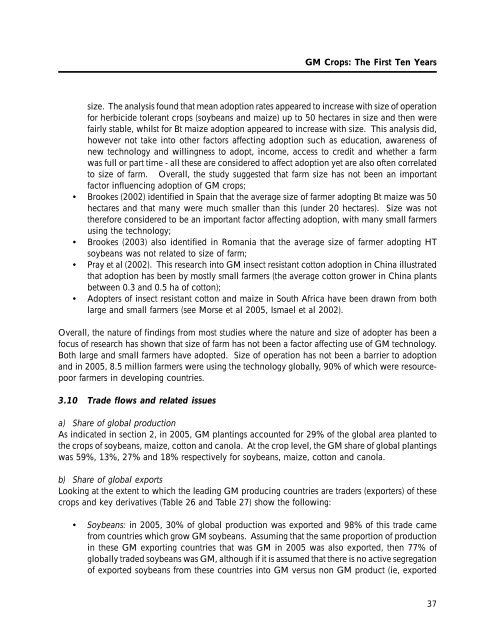GM Crops: The First Ten Years - International Service for the ...
GM Crops: The First Ten Years - International Service for the ...
GM Crops: The First Ten Years - International Service for the ...
You also want an ePaper? Increase the reach of your titles
YUMPU automatically turns print PDFs into web optimized ePapers that Google loves.
size. <strong>The</strong> analysis found that mean adoption rates appeared to increase with size of operation<br />
<strong>for</strong> herbicide tolerant crops (soybeans and maize) up to 50 hectares in size and <strong>the</strong>n were<br />
fairly stable, whilst <strong>for</strong> Bt maize adoption appeared to increase with size. This analysis did,<br />
however not take into o<strong>the</strong>r factors affecting adoption such as education, awareness of<br />
new technology and willingness to adopt, income, access to credit and whe<strong>the</strong>r a farm<br />
was full or part time - all <strong>the</strong>se are considered to affect adoption yet are also often correlated<br />
to size of farm. Overall, <strong>the</strong> study suggested that farm size has not been an important<br />
factor influencing adoption of <strong>GM</strong> crops;<br />
• Brookes (2002) identified in Spain that <strong>the</strong> average size of farmer adopting Bt maize was 50<br />
hectares and that many were much smaller than this (under 20 hectares). Size was not<br />
<strong>the</strong>re<strong>for</strong>e considered to be an important factor affecting adoption, with many small farmers<br />
using <strong>the</strong> technology;<br />
• Brookes (2003) also identified in Romania that <strong>the</strong> average size of farmer adopting HT<br />
soybeans was not related to size of farm;<br />
• Pray et al (2002). This research into <strong>GM</strong> insect resistant cotton adoption in China illustrated<br />
that adoption has been by mostly small farmers (<strong>the</strong> average cotton grower in China plants<br />
between 0.3 and 0.5 ha of cotton);<br />
• Adopters of insect resistant cotton and maize in South Africa have been drawn from both<br />
large and small farmers (see Morse et al 2005, Ismael et al 2002).<br />
Overall, <strong>the</strong> nature of findings from most studies where <strong>the</strong> nature and size of adopter has been a<br />
focus of research has shown that size of farm has not been a factor affecting use of <strong>GM</strong> technology.<br />
Both large and small farmers have adopted. Size of operation has not been a barrier to adoption<br />
and in 2005, 8.5 million farmers were using <strong>the</strong> technology globally, 90% of which were resourcepoor<br />
farmers in developing countries.<br />
3.10 Trade flows and related issues<br />
<strong>GM</strong> <strong>Crops</strong>: <strong>The</strong> <strong>First</strong> <strong>Ten</strong> <strong>Years</strong><br />
a) Share of global production<br />
As indicated in section 2, in 2005, <strong>GM</strong> plantings accounted <strong>for</strong> 29% of <strong>the</strong> global area planted to<br />
<strong>the</strong> crops of soybeans, maize, cotton and canola. At <strong>the</strong> crop level, <strong>the</strong> <strong>GM</strong> share of global plantings<br />
was 59%, 13%, 27% and 18% respectively <strong>for</strong> soybeans, maize, cotton and canola.<br />
b) Share of global exports<br />
Looking at <strong>the</strong> extent to which <strong>the</strong> leading <strong>GM</strong> producing countries are traders (exporters) of <strong>the</strong>se<br />
crops and key derivatives (Table 26 and Table 27) show <strong>the</strong> following:<br />
• Soybeans: in 2005, 30% of global production was exported and 98% of this trade came<br />
from countries which grow <strong>GM</strong> soybeans. Assuming that <strong>the</strong> same proportion of production<br />
in <strong>the</strong>se <strong>GM</strong> exporting countries that was <strong>GM</strong> in 2005 was also exported, <strong>the</strong>n 77% of<br />
globally traded soybeans was <strong>GM</strong>, although if it is assumed that <strong>the</strong>re is no active segregation<br />
of exported soybeans from <strong>the</strong>se countries into <strong>GM</strong> versus non <strong>GM</strong> product (ie, exported<br />
37
















